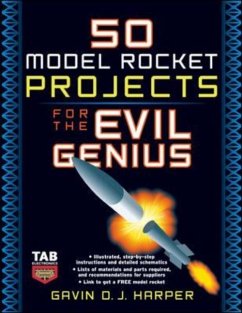The fun, hands-on way to learn about rocket science Yes, as a matter of fact, is IS rocket science! And because this book is written for the popular Evil Genius format, it means you can learn about this fascinating and growing hobby while having run creating 50 great projects. You will find a detailed list of materials, sources for parts, schematics, and lots of clear, well-illustrated instructions. Projects include a camera rocket, video camera rocket, hydrogen-fueled rocket, UFO, and more Projects start out basic and gradually become more sophisticated Perfect for science fairs and school projects
This full-size (8" x 11") paperback book written by Gavin D. S. Harper was a fun read for this longtime rocketeer (since 1966). True to its title, the book is focused on various aspects of model rocketry and continually emphasizes safety. Even with fourteen years in HPR, I found the material interesting and informative. The projects and information described in the book vary from simple to quite complex. Projects include basic model rocketry, staging, clustering, launch systems, recovery systems, wind tunnels, payloads, and more. The work is well illustrated with both pictures and schematics. In addition to step-by-step instructions, there are good technical tips, and it is all written in an easy-to-follow order. There are also numerous other features in addition to "build" projects. A brief discussion of rocketry history starts the book, ranging from the invention of black powder to the U.S. manned moon landing. Real rocket science interspersed in each chapter simply but accurately explains much of the physics of rocketry. The more technical aspects of our hobby are presented toward the end of the book. These features include rocket math, flight computers, and camera rockets. This book works well with fun parent/child activities. Simple motors can be put together from 35mm film cans with propellant components such as vinegar and Alka-Seltzer tablets. More complex motors using hydrochloric acid with hydrogen peroxide are also detailed. The wind-tunnel segment was very practical, and I wish that I'd had this available in my younger years when designing my early models. Chapter 5 is a particularly valuable section for the beginner. There are descriptions and pictures of the construction techniques of all parts of a simple model rocket. It then goes on to cover multistage rockets, boost-gliders, cone rockets, and flying saucers. Probably the most difficult part of successful rocketry, whether it be of model or mid- or high-power, is the recovery system. Chapter 6 has a very good series of sections on various recovery methods and even includes a descent-rate table. The end of Chapter 6 includes articles on constructing strobes for night launches. Chapter 7 covers launching of model rockets. Again, some very good parent/child projects are described in word and illustration. Several practical launch controllers and pads are described, including construction of a tower launcher. More advanced items, such as clustering and igniters, are also detailed. The latter chapters discuss more advanced subjects, such as rocket math, aerial photography (still and movie), Barrowman stability, altitude determination, and flight computers. Some of the features I found most interesting were the items about making black powder and the explanation of nozzles and aerodynamics. The book is an easy read in both the length of each feature and the writing style. Do not expect any HPR information, simply enjoy the book for what it is: a good beginners guide that also is interesting to the experienced rocketeer. If you are a high power enthusiast who is into EX/research motors, ignore the warning on page 9 of the book. To find out what that is, check out 50 Model Rocket Projects for the Evil Genius. Rockets Magazine 20070801

